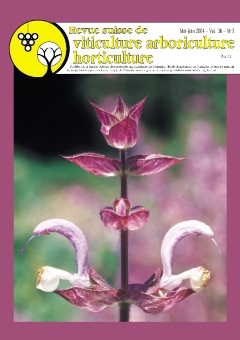
Issue 3 - May - June 2004
Abstract in open access
Nine insecticides were incorporated at different concentrations in artificial diet to determine their larvicidal effectiveness on grapevine moth Lobesia botrana from a laboratory strain originally collected in the Lake of Geneva region. A first evaluation was made after 14 days of rearing. Surviving individuals were kept then until adult emergence. Dose-mortality curves have been established. Efficiency varied greatly among the tested insecticides. Seven out of 9 products had a good potential to control grapevine moths as their LC50 values ranged from 0.05 to 1 ppm: methoxyfenozide, flufenoxuron, indoxacarb, tebufenozide, teflubenzuron, spinosad and chlorpyrifosmethyl. Concerning chlorpyrifos-ethyl (Pyrinex), its high LC50 of approximately 60 ppm can be attributed to the microencapsulated formulation that probably does not allow a good diffusion of active ingredients into the diet. Diflubenzuron does not present any interest for controlling grapevine moth.
Key words: grape berry moth, insecticides, artificial diet, Lobesia botrana.
Keywords:
E-Mail:
Adress: Agora
Abstract in open access
From 1997 to 2002, trials on yield control by suppressing bunches of grapes after the «pea-size» stage were carried out on Merlot grapes on the Gudo experimental estate of Federal agricultural research station Agroscope RAC Changins in Ticino. Two different yield levels were compared: one with little or no restrictions; and the other heavily restricted. Agronomic, analytical and organoleptic parameters were monitored. Comparisons of vinification were made throughout the trials. Relatively little improvement in must sugar content due to yield control was noted in the Merlot variety of grape (0.3 °Oe per 100 g/m2 on average). It was more noticeable when the initial yield was greater (from the vines with little or no yield control). Must acidity tended to decrease with lower yields. Analytical differences between wines were small. Wines produced from grapevines where yields were heavily restricted were generally preferred to those made from crops with little or no yield control.
Key words: crop level, cluster thinning, must and wine composition, wine quality.
Keywords:
E-Mail:
Adress: Agora
Abstract in open access
The influence of the harvesting date on must and wine quality has been studied from 1996 to 1999 on the cultivar Gamaret at Agroscope RAC Changins in Nyon (VD).
The experiments were designed to compare two harvesting time: identical to that of the cultivars Pinot noir and Gamay and late one around mid-October.
The must of late harvested grapes had a lower content in tartaric and malic acids. The wines were more coloured and had a higher content in phenolic compounds; they were always preferred in wine tasting as they presented a better structure and a better quality of the tannins.
Key words: Vitis vinifera, Gamaret, harvesting date, wine quality, phenolic compounds.
Keywords:
E-Mail: jean-laurent.spring@agroscope.admin.ch
Adress: Agora
Abstract in open access
The incidence of cluster sun exposure on the quality of grapes and wines was studied in a trial set up with the cv. Chasselas on the experimental vineyard of Agroscope RAC Changins at Pully (VD). The interaction between orientation of the rows and a permanent grass cover (60-70% of the surface) was also studied. The first part of the study presents the results obtained about the light and the thermic microclimates of the bunches. The foliage manipulation in the cluster zone (elimination of leaves) considerably modified the light and thermic microclimates of the bunches. The orientation of the rows influenced the microclimate dynamics of the bunches; the E-W oriented rows were more strongly exposed to the sun during the afternoon. The presence of permanent grass cover generally slightly increased light exposure and cluster temperature but the influence was rather low.
Key words: grapevine, defoliation, sunlight exposure, cluster microclimate, cluster temperature.
Keywords:
E-Mail: dominique.maigre@bluewin.ch
Adress: Agora
Abstract in open access
Light is one of the key factors for fruit quality. Exposure of leaves (cultivar Golden Delicious) mainly determines the dynamic of non structural sugar accumulation in the fruits. Poorly exposed branches are strongly dependent on well illuminated tree parts for sugar supply. Among the carbohydrates analysed, sucrose and starch are positively correlated with light exposure. Fructose concentration is equivalent all along the season at any illumination intensity. In contrast, high glucose content is clearly associated with shading conditions in the tree.
These results as well as other fruit quality attributes can help to find adapted training systems for apple. They may be used as a model for interrelationship between tree shape, orchard height and fruit quality.
Key words: apple, fruit quality, light exposure, non structural carbohydrates, sucrose, starch, fructose, glucose.
Keywords:
E-Mail:
Adress: Agora

 Download of full issue
Download of full issue
 Download article
Download article